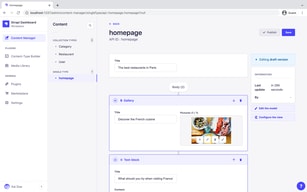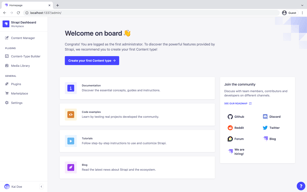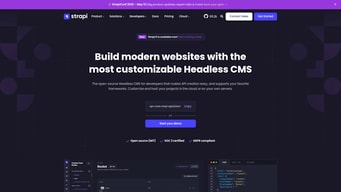

Unclaimed: Are are working at Strapi ?
Strapi Reviews & Product Details
Strapi is a free, open-source, and headless/back-end-only CMS that runs on 100% Javascript. Made for developers, it’s fully customizable and provides a robust environment for creating self-hosted and high-performing content APIs. Content creators can easily define models to build rich layouts depending on the data structure they need for their business. Once a content architecture has been set, it’s seamless to write, edit, and manage any content type. Comprehensive frameworks and services from third-party vendors are available to reinforce the content environment and once ready, content can be easily deployed on all cloud platforms or traditional servers.

| Capabilities |
|
|---|---|
| Segment |
|
| Deployment | Cloud / SaaS / Web-Based, Desktop Linux, Desktop Mac, Desktop Windows, On-Premise Linux, On-Premise Windows |
| Support | 24/7 (Live rep), Chat, Email/Help Desk, FAQs/Forum, Knowledge Base, Phone Support |
| Training | Documentation |
| Languages | English |






Compare Strapi with other popular tools in the same category.

It can be used as a simple and easy-to-use CMS without any complications and comes with built-in graphQL support, API tokens with custom permissions, localization and ready to pair with Next.JS! And all of these features can be used under a community license without any fees.
I have been trying it for 2 days, haven't found any issues yet.
Quick and easy to manage content management system
The interface is easy to grasp and implement. Creating carousels and video feed within our app has optimized thanks to strapi.
Its difficult to manage the team and add more users for non-tech people like me.
Strapi is helping us deploy in app banners and carousels on different screens. We also use it for uploading videos in different categories for our in-app training.
Strapi is a great CMS(Content Management System) which provide a lot of great features like easy integration with the product, fast content change, inbuilt editor with multiple formatting options. The content also includes and option to support media files.
Although Strapi is a great product, but there is one thing that can be improved which is the editor provides a very limited formatting options. The editor is a bit basic.
We are using strapi as content management system for our course content in Learning Management System. We also use strapi for managing the content of our blogs and events.
For us, as a non-profit organization with limited funds, Strapi offers one of the best solutions on the market when it comes to headless CMS: - It’s easy to install and configure - It can be deployed to a PaaS (e.g., Heroku) such that we don’t have to deal with the runtime environment, OS and so on - We keep complete control over UI, extensions, data, and models - Maximum flexibility through extensions, i.e., use the HTML editor of your choice - It is open source - Excellent documentation—most questions have been asked and answered before - GraphQL API (it’s an extension)
Unfortunately, this highest flexibility comes at a cost: We have to install, deploy, and test it ourselves, but Strapi is about to launch the Strapi Cloud bringing this flexibility to a SaaS. So don’t take this dislike too serious.
We are developing new projects on a modern tech stack, e.g. with NextJS. Thus, we heavily rely on a predictable and potent API. With Strapi, we can decide whether to consume REST or GraphQL—both work well. Editors get a fantastic user experience with components in models, the media manager, and the navigation extension for drawing the site’s/menu structure.
Overall content management is so great. And the best part is the API services that we are getting out of the box.
I feel Strapi 3 Dashboard UI/UX was better than Strapi 4.
It is solving our scalability issue.
I really like Strapi, it make products management very easy and it's a very ergonomic software.
The only think I don't really like is that to change the defaults role, you need to have a premium subscription
Strapi is solving management problems by making them easier to manage
Speed of production and the ability to create custom functions easily in NodeJS through its framework. As much as its advertised as a CMS, its much more powerful than that - i've used it for developing an internal HR system for governments, School Websites & LMS Integrations.
I have not encountered any problems with this application so far.
1) Speed of Production. 2) User Management. 3) Content Management. 4) Ease of Deployment 5) Admin UI/UX
Strapi promotes an API-first way of doing web. It delivers a means to build quickly and efficiently a valuable API, which is what you should expect from the modern web.
Graphic Design could be a little more colorful.
Ship fast standard web applications.
The plugin system is generally really simple to get started with and enabled us to quickly extend our installation, such as using Cloudinary as a CDN. Similarly, it's proven quick to build with, and the plug-and-play GraphQL support meant we could integrate with our TypeScript codebase easily.
Sometimes the errors when plugins conflict are really obscure, and I wish that content management was viewable as a top-level navigation item, instead of it being a sub-menu.
We replaced our website and needed CMS that was more customisable than we were previously using. It has so far proven itself in this way. Specifically, our team seems to be able to navigate it with ease.
Super quick to get up and running. Allowed us to build out our CMS quickly, allows us to generate our site dynamically and allow our non-technical staff to view all of our relevant data items and page content without hassle.
It would be great if the top-level navigation could be customized. It would be great to bring out certain object types such as from within the content manager and "pin" them to the top-level navigation.
Providing a centralised API/CMS solution that we can sync our various other tools such as Salesforce too, allowing us to request data easily and in a quickly customisable manner.





